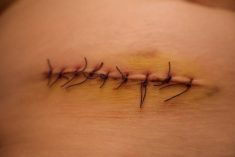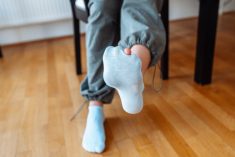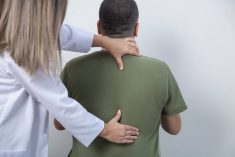Joint pain during movement, aching joints at rest or during weather shifts, stiffness and even audible grinding or clicking during movement are all symptoms of a common diagnosis: osteoarthritis.
Classified as the symptoms associated with the gradual wear and tear on the joint cartilage, osteoarthritis is most commonly experienced in the knees, hips, low back and hands. It affects all genders, all activity levels, backgrounds and lifestyles and though commonly experienced in the previously listed joints, it can be found in any joint in the body.
In most cases, osteoarthritis is considered a relatively common, normal part of aging.
Read Also

Gentle treatments for pain in the neck
Heading toward year-end, people unknowingly tense up against the cold and busyness, causing neck pain that can often be treated with appropriate support and gentle mobility, athletic therapist Kathlyn Hossack says.
A common misconception about osteoarthritis is that it is a genetic predisposition. While there isn’t much evidence to support the idea that genetically some of us are more vulnerable to developing osteoarthritis than others, there is an anecdotal and logical explanation for this belief. Humans learn by watching and mirroring those around them during their childhood. How we move, our biomechanics, over the long term can impact our joint health. While there are many factors that influence how we move and hold our posture, many of us learn from an early age how our parents, older siblings or other caregivers moved, picking up very subtle patterns that set the stage for the rest of our lives. This is one explanation for why you, your mother and your grandmother all developed the osteoarthritis around the same age or at some point.
Just like our movement quality over a lifetime can influence when or if we experience symptoms of osteoarthritis, other lifestyle factors do as well. How much we move, the intensity of our lifestyles, stress levels, other health conditions, our levels of nourishment, physical and emotional trauma all have a role to play in how our joints age.
Another common myth associated with the diagnosis of osteoarthritis is that it means a destiny filled with pain. Research has found that many people who have observable osteoarthritic changes in their joints do not report associated pain or dysfunction, and those who report pain or dysfunction often do not have significant changes to their joint structure. This suggests that pain is not relative to severity of osteoarthritic change, and more often than not pain is determined by other factors (postural, environmental, and psychological stressors are among the top triggers for pain).
There are many really effective tools for managing osteoarthritis if it is affecting your lifestyle. Finding ways to move your body and all your joints will help keep your joints feeling good, even if they aren’t brand new anymore! Gentle, low-impact movement practices like yoga, pilates, and swimming are great places to begin. Massage, acupuncture, and myofascial cupping may all have positive effects on osteoarthritis symptoms, especially when combined with a personalized movement program in between treatments.
Orthopedic bracing has a savvy brace known as the “unloader” brace, which effectively works for the knees to change how force travels through the joint and “unload” the part of the joint that has structural changes occurring.
When other joints are affected, consistent movement practices, appropriate nutrition and stress management techniques have all been shown to help mitigate the symptoms often associated with osteoarthritis.
In many cases a joint replacement surgery is done. Most of the time surgeons prefer to wait until the majority of the joint has degenerated, or the patient’s dysfunction is quite significant before doing this, as it is quite an intense surgery, but usually quite effective. The surgery sets the stage and the pre- and post-op care in terms of rehabilitation ensures the performance. Developing a relationship with a movement-focused professional and hands-on therapy professionals can both help before surgery and after to secure long-term, pain-free function.
It is important to recognize that osteoarthritis is a normal part of human aging and does not have to coincide with pain, loss of function, or less quality of life. There are many tools out there to help mitigate pain and move well even through joint changes. If you’re experiencing pain that you believe might be related to osteoarthritis, seek professional guidance from your usual health-care providers and musculoskeletal-focused wellness providers.















